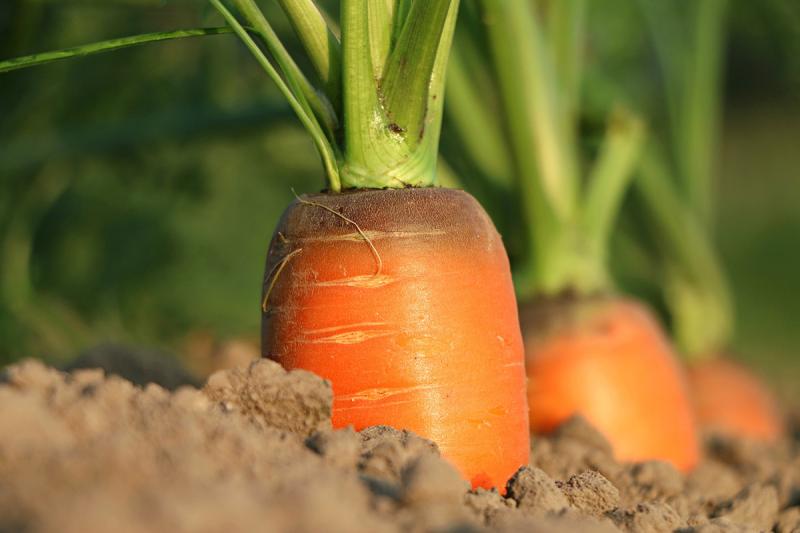Sarah Browning, Nebraska Extension Educator

There are many ways we can enjoy carrots in, salads, vegetables and desserts. Image by Pixabay.com
Many desserts will grace our holiday tables this week and for many carrot cake is a favorite - although pumpkin, sweet potato and pecan pie all get more attention during Thanksgiving. Carrots make a great side dish, too, as in honey glazed carrots, maple dill carrots or refreshing carrot cranberry salad.
Wouldn’t it be cool to grow your own carrots for next year’s Thanksgiving table? If you have never tried growing carrots in the past, give it a try next summer!
Start with Good Soil
To grow well-shaped root vegetables like carrots, ideally a gardener would start with a light sandy loam soil. Unfortunately, Nebraska gardeners aren’t typically blessed with sandy loam soil, so create your own in a raised bed or grow carrots in large containers. Sandy loam soil is made up of approximately 45-50% sand, plus 50% or less silt soil and 7% or less clay soil.
However, carrots will grow fine in soils with higher clay content as long as the soil is well-drained, loose and not compacted. Manually loosen the soil with a spade or pitchfork before planting, making sure to remove any rocks, heavy soil clods or other debris from the planting area to prevent forked or misshapen roots. Smooth the soil to a nice workable surface.
Cultivars with short fat roots perform best in Nebraska soils; these include Chantenay types and miniatures like Little Finger and Gold Nugget. Moderately long-rooted cultivars include Danvers and Nantes types can also be grown, but avoid the long-rooted Imperator types unless you garden in very sandy soil.
Carrots prefer soil pH between 6 and 7.

Growing Tips
Always direct seed carrots in the garden; they begin to develop tap roots very quickly and don’t respond well to transplanting. Damaged roots will likely fork or become misshapen.
In Lancaster county, begin seeding carrots around early April if the soil is dry and workable. Soil temperatures for carrot germination are minimum 40°F, optimum 45-85°F and maximum 95°F. No germination will occur when temperatures are below 40°F or above 95°F.
Carrot seeds are quite small, making distributing seed evenly rather difficult. A couple options to make seeding easier include using pelleted seeds, which have a clay coating, and are bigger and easier to handle. Or buying carrot seed tapes with a pre-determined seed spacing (or make your own). Finally, you can mix the carrot seeds with a small amount of sand, making it easier to get an even distribution of the sand/seed mixture throughout the planting area.
Plant seeds ¼-1/2 inch deep in moist soil.
Carrot’s small seeds produce equally small plants initially, with the first two leaves looking like thin grass blades. These tiny leaf blades have trouble emerging through crusted soil – caused either through compaction, including rain compaction, or soil dryness. Keep the soil surface moist throughout the planting area until plants have emerged. Some gardeners sprinkle a light layer of fine sand over their rows to hold in soil moisture and prevent crusting. Later foliage will be frilly or fern-like, the look usually associated with carrot leaves.
Some gardeners choose to plant carrots and radishes in the same row. Radish seeds germinate quickly to mark the rows and can be harvest typically within 30-45 days, leaving the carrots more room to develop.

For the most efficient use of garden space, plant carrots in wide rows and thin them evenly, allowing 1-2 inches between plants or as directed on the seed label for large-rooted cultivars. Wide row plantings are usually about 36 inches across, with plants evenly spaced through the area, minimizing the amount of space needed for walking rows.
Thin out the largest plants first, allowing the smaller plants more space and time to develop.
Use row covers to speed up early crops and keep insects, like root maggots and carrot weevils, away.
Carrots require good soil moisture to develop well and have good flavor. Too little water results in bitter, tough, fibrous, misshapen and undersized roots. Provide 1 inch of water per week, either through irrigation or rainfall, soaking the soil 6-8 inches deep.
Control weeds to prevent them from stealing moisture and shading your carrots. Frequent, shallow hoeing will kill weeds before they become a problem. Just be careful not to damage the carrot roots!
For more information on growing and harvesting carrots, check out the following publications.
- Growing Carrots and Parsnips in Home Gardens, University of Minnesota
- Carrots, Cornell University
Images from Pixabay.com.
Search Our Archive
Associated Video
Soil Temperatures for Planting
UNL Extension Educator Sarah Browning gives tips for planting various produce and keeping an eye on soil temperatures